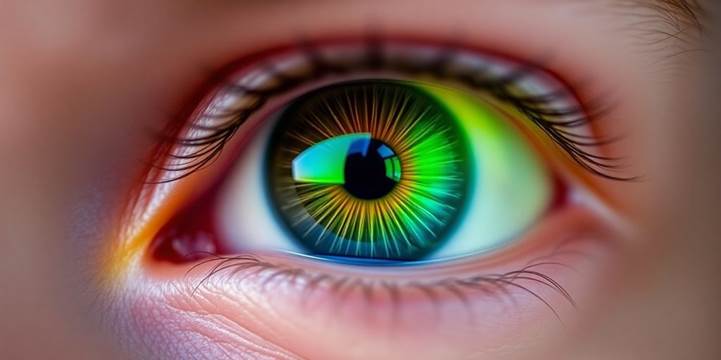Color blindness, or more accurately, color vision deficiency, affects how people perceive colors. It’s not about seeing in black and white, but rather having difficulty distinguishing between certain shades. This can make everyday tasks surprisingly challenging.
- How Color Blind Contacts Enhance Color Perception
- The Science Behind Color Blind Contact Lenses
- Types of Color Vision Deficiency and Lens Solutions
- The Functionality of Color Blind Contacts
- Benefits of Using Color Blind Contacts
- Choosing and Using Color Blind Contacts
- Availability, Cost, and Alternatives
- Limitations and Considerations for Color Blind Contacts
- Seeing the World Differently
Specialized contact lenses are now available that aim to help individuals with color vision deficiency see the world more vibrantly. These lenses work by filtering specific wavelengths of light, which can make it easier to tell colors apart. They don’t cure color blindness, but they can significantly improve color perception for many.
How Color Blind Contacts Enhance Color Perception
These lenses work by selectively filtering light. Think of it like putting on sunglasses that only block certain colors of light. By doing this, the lenses can make colors that were previously hard to distinguish appear more different from each other. This means reds might look redder, and greens might look greener, for example.
The Science Behind Color Blind Contact Lenses
At their core, color blind contact lenses contain special filters, often in the form of a gel or film embedded within the lens material. These filters are designed to absorb specific wavelengths of light that are problematic for people with certain types of color vision deficiency.
Products like ColorKinds color blindness contacts use this technology to enhance color perception for men and women, helping wearers experience a richer and more accurate range of colors.
By altering the light that reaches the retina, these lenses can help the brain better differentiate between colors that would otherwise appear similar.
Types of Color Vision Deficiency and Lens Solutions
Color vision deficiency isn’t a one-size-fits-all condition. The most common type is red-green color blindness, where distinguishing between reds and greens is difficult. For this, chromatic lenses are often recommended. Less common is blue-yellow color blindness, which can be addressed with anomalous lenses. In rare cases of achromatopsia, or total color blindness, even these specialized lenses may offer limited improvement, but advancements are ongoing.
It’s important to remember that these lenses are tools to aid perception, not a cure. The effectiveness can vary greatly from person to person.
The Functionality of Color Blind Contacts
Filtering Light for Improved Color Distinction
Color blind contacts work by selectively filtering certain wavelengths of light. Think of it like putting a special filter on a camera lens. These lenses are designed with specific tints that absorb light in a way that helps the wearer better distinguish between colors that they might normally confuse. For instance, someone with red-green color blindness might struggle to tell the difference between a red and a green traffic light. These contacts can make those colors appear more distinct, improving safety and everyday navigation.
Enhancing Contrast Between Confusing Hues
Beyond just filtering, these specialized lenses also boost the contrast between colors that are typically hard to differentiate. This means that shades that used to blend together for the wearer can now stand out more clearly. The goal is to make the visual experience richer and more accurate, allowing for a greater appreciation of the world’s color palette. The effectiveness of these contacts lies in their ability to subtly alter how light reaches the eye, creating a more defined separation of colors.
How Lenses Aid in Differentiating Reds and Greens
For individuals with the most common form of color vision deficiency, red-green color blindness, these lenses are particularly helpful. They are engineered to reduce the overlap in how the eye perceives red and green light. This adjustment allows the wearer to see these specific colors with greater clarity. While they don’t
Benefits of Using Color Blind Contacts

Color blind contacts offer a tangible way for individuals with color vision deficiencies to experience the world with greater clarity. These specialized lenses work by filtering light, which helps to separate colors that might otherwise appear muddled. This can lead to a more vibrant and accurate perception of the visual spectrum. For many, the ability to distinguish between shades that were previously indistinguishable is a significant improvement.
Improved Vision in Everyday Activities
Daily tasks that rely on color recognition can become much simpler. Think about identifying traffic lights, choosing ripe produce at the grocery store, or even coordinating outfits. Color blind contacts can make these everyday activities less of a challenge. The subtle yet significant shift in color perception can reduce frustration and increase independence. This improved color distinction is a key benefit for many users.
Academic and Professional Advantages
In educational and work environments, color plays a vital role. Students might find it easier to interpret charts, graphs, and diagrams in textbooks or presentations. Professionals in fields requiring precise color identification, such as design, engineering, or certain medical roles, may find these lenses beneficial. Passing color vision tests, like the Ishihara test, can also be a direct advantage, opening doors to specific career paths. The discreet nature of contact lenses means this assistance is often unnoticeable to others.
Enhanced Recreational Experiences
Hobbies and leisure activities can also be transformed. Sports enthusiasts might find it easier to track the ball, distinguish team colors on the field, or read scoreboards. Even activities like playing board games or appreciating art can become more engaging when colors are perceived more accurately. The ability to see a wider range of colors can simply make life more colorful and enjoyable.
Safety Improvements in Daily Life
Safety is a paramount concern, and color blind contacts can contribute to it. Being able to clearly differentiate between the red and green lights on a traffic signal is a prime example. Similarly, recognizing warning signs or indicators that rely on color coding can be improved. This enhanced ability to perceive critical color cues can lead to a safer daily experience for the wearer.
Choosing and Using Color Blind Contacts
Consulting with an Eye Care Professional
Before you even think about buying color blind contacts, the first step is always to see an eye doctor. They’re the ones who can really figure out what kind of color vision issue you have. It’s not a one-size-fits-all situation, you know? They’ll do tests to see exactly where your color perception is a bit off. This professional assessment is key to finding lenses that actually work for you. They can recommend specific types of color blind contacts tailored to your unique needs, making sure they’re both effective and comfortable.
Understanding Personal Experiences and Adjustments
People’s experiences with these lenses can really vary. Some folks find they can suddenly tell the difference between shades they never could before, which is pretty neat for everyday stuff or even work. Others might feel a bit weird at first as their eyes get used to the new way of seeing colors. It can take a little time for your brain to adjust to the filtered light, but most people find it gets better with patience. It’s important to have realistic expectations; the changes might be subtle for some, while others notice a big difference. Hearing about others’ experiences can be helpful, but your own journey with color blind contacts will be personal.
Selecting the Right Color Blind Contacts for Your Needs
Picking the right pair of color blind contacts is a bit like choosing any other corrective lens – it needs to be the right fit for you. After your eye doctor has assessed your specific color vision deficiency, they can guide you on which types of lenses might be most beneficial. Factors like the severity of your color blindness and your lifestyle play a role. For instance, someone who needs to distinguish traffic lights might benefit from a different type of lens than an artist looking to perceive subtle color variations. It’s all about matching the lens technology to your personal requirements.
Remember, these lenses aren’t a magic cure, but they can certainly help you experience the world in a new way.
It’s important to remember that color blind contacts are designed to filter light in specific ways. This filtering helps to increase the contrast between colors that might otherwise look similar to someone with a color vision deficiency. For example, many people with red-green color blindness find it difficult to distinguish between certain shades of red and green. The lenses work by selectively blocking or transmitting certain wavelengths of light, making those problematic colors stand out more distinctly. This targeted approach is what makes color blind contacts so effective for many users.
Availability, Cost, and Alternatives

Accessibility of Color Blind Contact Lenses
Color blind contact lenses are becoming more accessible, with a growing number of optical shops and online retailers stocking them. However, getting a prescription from an eye care professional remains a necessary step. This ensures you get lenses that are safe and effective for your specific needs. Finding the right supplier is key to accessing these specialized lenses.
Cost Analysis of Specialty Contact Lenses
The price of color blind contacts can vary quite a bit. Factors like the complexity of the lens design and the company selling them play a role. These specialty lenses are generally more expensive than regular contacts because of the advanced technology used to filter light. Many insurance plans don’t cover them, so you might end up paying out-of-pocket. It’s a good idea to compare prices from different places to find a more affordable option.
Exploring Alternatives to Color Blind Contacts
For those not opting for contact lenses, other solutions exist. Color blind glasses are a popular choice, using special lenses to help distinguish colors better. These glasses can make it easier to tell apart shades that are usually confusing. Another option includes smartphone apps with adjustable color filters that can modify what you see on your screen. Some people also find vision therapy or special lighting helpful in managing color vision deficiency. These alternatives can work alongside contacts or serve as standalone solutions.
It’s important to remember that while these lenses can help, they don’t cure color blindness. They work by filtering light to improve color distinction.
Limitations and Considerations for Color Blind Contacts
Understanding the Limitations of Corrective Lenses
While color blind contact lenses can be a game-changer for many, it’s important to know they aren’t a magic bullet. These lenses don’t actually restore normal color vision. Instead, they work by filtering light, which can help improve the way certain colors are perceived. Think of it as a helpful tool, not a cure. The effectiveness can really depend on the specific type and how severe the color blindness is. Some people might see a big difference, while for others, the change might be more subtle. It’s all about managing expectations with these specialized lenses.
Factors Influencing Lens Effectiveness
Several things can affect how well color blind contacts work for someone. The type of color vision deficiency plays a big role; lenses designed for red-green issues might not work the same way for blue-yellow deficiencies. The severity of the deficiency also matters. Even the way light hits the eye and how an individual’s brain processes visual information can influence the outcome. It’s not a one-size-fits-all situation, and what works wonders for one person might be less impactful for another. Getting the right fit and type is key.
The Importance of Realistic Expectations
It’s really important to go into using color blind contacts with a clear head about what they can and can’t do. They are designed to assist in distinguishing colors, not to grant perfect color vision. Some users report initial discomfort as their eyes adjust, which usually fades. Others might find the improvements are more noticeable in specific situations, like distinguishing traffic lights or certain shades at work. Patience during the adjustment period is often rewarded as the brain gets used to the new visual input. Ultimately, the goal is an improvement in color perception, not a complete transformation.
Seeing the World Differently
So, while these special contacts aren’t a magic fix for color blindness, they do offer a way for many people to experience colors more vividly. They work by filtering light, which helps sort out confusing shades, especially reds and greens. It’s a good idea to chat with an eye doctor before trying them out, just to make sure they’re the right choice for your specific needs. Even though they don’t cure the condition, these lenses can make a real difference in everyday tasks and hobbies, letting people see the world with a bit more color.















